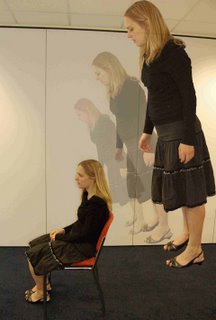Sunny waves
Boulder, Colorado: Embargoed for release: 30- The sun is the most familiar object in the sky - One of the most puzzling is the fact that the outer layers of the sun's atmosphere, which is called the corona, are far hotter than the surface of the sun. This is very hard to understand. Scientists have compared it to a kettle boiling merrily on top of a block of ice. One possible explanation is that heat is carried upwards by a special kind of wave called an Alfvén wave. Now scientists for the first time have observed Alfvén waves in the corona. The discovery gives them an insight into the behaviour of the sun and its magnetic field. It should also lead to a better understanding of how the sun affects the earth and the rest of the solar system. The research was led by Steve Tomczyk of the National Center for Atmospheric Research (NCAR). It is published this week in Science. "Alfvén waves can provide us with a window into processes that are fundamental to the workings of the sun," says Tomczyk. Alfvén waves are fast- Alfvén waves are hard to detect. This is partly because, unlike other types of wave, they don't create large disturbances in the corona. Also the changes in velocity they cause are small and not easily noticed. "Our observations allowed us to unambiguously identify these oscillations as Alfvén waves," says co- "The waves are visible all the time and they occur all over the corona.” This was a surprise to the researchers, he added. By tracking the speed and direction of the waves, researchers should now be able to work out basic properties of the sun's atmosphere. These include its density and the direction of its magnetic fields. The research may also help scientists to predict solar storms. These are extremely violent events that spew thousands of tons of matter into space in the form of energetic particles. When these particles hit earth's atmosphere they cause the aurora borealis, the northern lights. They can also have much less appealing effects, by blocking radio signals, causing electrical blackouts and damaging satellites. In March 1989 a solar storm caused a complete blackout of the city of Quebec. Learning more about solar storms might also help to protect astronauts from dangerous levels of radiation in space. "If we want to go to the moon and Mars, people need to know what's going to happen on the sun," Tomczyk says. To observe the waves, Tomczyk and his colleagues used an instrument developed at the National Center for Atmospheric Research over the last few years. The coronal multichannel polarimeter (CoMP) is attached to a telescope at the National Solar Observatory in New Mexico. It is a special instrument designed to gather light from the corona. This is much dimmer than the sun itself so is difficult to see against its glare. The CoMP then tracks magnetic activity around the entire edge of the sun. It works fast, making a measurement as often as once every 15 seconds. With the help of this instrument the research team were able to capture intensity and velocity measurements and polarisation images of the solar corona, all at the same time. Those measurements and images revealed waves that were moving in paths that lined up with magnetic fields, and travelled at almost 2,500 miles per second. So can these newly- But the possibility remains that other, stronger Alfvén waves carry enough energy to do so. The mystery of why the kettle is boiling on the block of ice has not yet been completely solved. More help with words atmosphere disturbances orbit orbits plane planet vibration What's it all about? More science teaching resources for this story
Topic for discussion, research or pupil presentations
Stanford University has an excellent collection of sun science investigations, activities and discussion topics. These include retrieving solar images, understanding the solar scale and an interview with Mr Sol: "Have you ever wondered what our star thinks about his (or her?) role up there in the sky? Have you considered what an awesome responsibility it must be, generating all that heat and light from fusion and having so many living beings depending upon you? Sol really does light up our life. Imagine what he might say if you could interview him. Why don't you do a little research (this web site is a good place to start) and then you and a friend create your own interview with Mr. Sol! If you come up with a good interview, send it to us and we'll publish it here on the web!" Tips for science class discussions and groupwork No 60 Your students may not have the reasoning skills, or may not have the requisite prior knowledge to solve the problem you have given them. In either case you need to develop interventions which will chunk the ideas smaller while still giving them space to learn for themselves. Our inclination in this case, based on our own learning experiences as students, is to tell the students things they need to know to solve the problem. In so doing you take away, as you have pointed out, opportunities for them to learn. Perhaps you are telling too much and not instead developing a set of questions for the students to work on and discuss that will lead them to where you when you want them to be. .... Sometimes it seems to me that my students have a little mental switch in their heads, and I have to ask the right question to get them to turn it on. Often the question is "Explain your reasoning." Extract from a contribution to an NSTA teachers' forum by Joseph J. Bellina, Professor of Physics at Saint Mary's College, Notre Dame, Indiana

